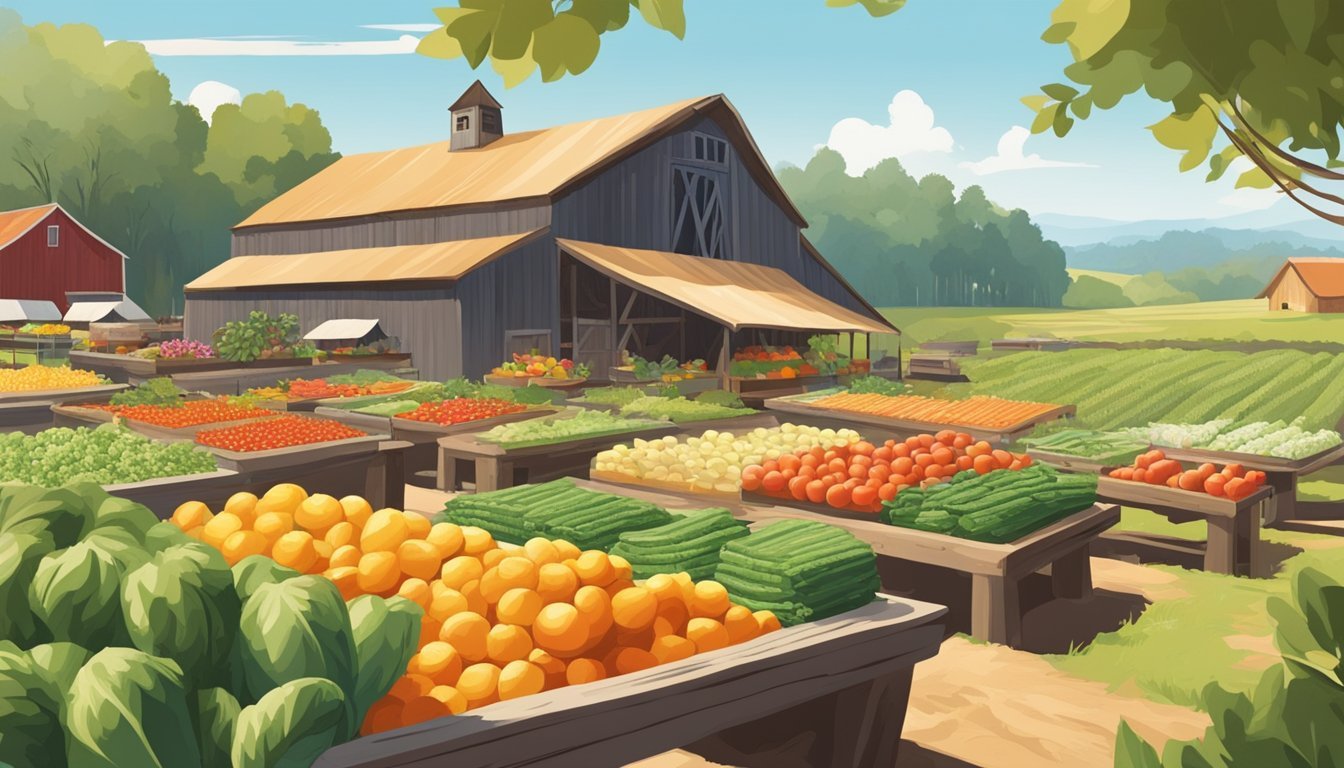An Introduction to the Farm to Table Idea
Embracing Local and Sustainable Food Systems
The farm to table concept revolves around a simple, yet impactful principle: sourcing food directly from local farms to the table, often bypassing the traditional steps of the food supply chain. This movement aims to connect consumers more closely with the origin of their food, emphasizing the importance of local produce, meat, and dairy. It promotes sustainable agricultural practices, bolstering local economies and reducing the environmental footprint associated with long-distance food transportation.
Key to the farm-to-table movement is the relationship between local farmers and consumers. Advocates of this approach argue that it leads to fresher, more flavorful, and often healthier meals. By prioritizing local sourcing, restaurants and individuals help ensure that food sales' financial benefits contribute to the local community, supporting local farmers and producers.
The movement isn't just a culinary trend but a response to growing concerns about the industrialized food system. With an emphasis on sustainability and economic resilience, the farm-to-table approach seeks to make food systems more transparent, allowing consumers to make informed choices about what they eat and where it comes from. This evolving modern food ethos demands heightened responsibility from both producers and consumers, for the benefit of communities and the environment.
The Origins of Farm-to-Table
The farm-to-table concept, emphasizing authenticity and sustainability, grew from historical roots, becoming a mainstay in modern cuisine and reflecting changing food trends.
Hippie Movement Influence
The 1960s hippie movement played a pivotal role in the farm-to-table ideology with its emphasis on self-sufficiency and environmental sustainability. This movement fostered an increased awareness of the origins of food and a preference for organic, locally sourced produce. It catalyzed a shift away from processed foods, setting the stage for farm-to-table dining experiences that mirrored the movement's values.
Chez Panisse and Alice Waters
In 1971, Alice Waters opened Chez Panisse in Berkeley, California, which soon became the bedrock of the farm-to-table movement. The restaurant distinguished itself by exclusively using fresh, local ingredients, and served as a model for emphasizing the relationship between farmers and chefs. Chez Panisse's success showed a growing appetite for quality, fresh foods and laid the groundwork for other restaurants to follow suit.
Evolution into Modern Movement
Over time, the concepts integral to farm-to-table gained in popularity and evolved into the broader movement experienced today. Now, it is a culinary trend and a commitment for consumers to eat their own food with an environmental and social consciousness. Chefs and consumers prioritize their food's origin, seeking to maintain a sustainable and transparent food supply chain, bolstering the movement's prevalence in contemporary dining culture.
Principles of Farm-to-Table
The farm-to-table movement emphasizes a connection between farmers, consumers, and the earth, striving to promote healthier food and more robust local economies.
Supporting Local Farms
The fundamental goal of farm-to-table is to support local farms and farmers by sourcing food directly from them. This patronage ensures that local farmers receive fair compensation, strengthening the community and economy. By purchasing from nearby farms, consumers contribute to preserving agricultural land and fostering relationships with those who cultivate their food.
Sustainability and Organic Practices
Sustainable agriculture is at the heart of the farm-to-table philosophy. Farmers engaged in this movement often follow organic farming methods and other environmentally friendly practices. It involves maintaining soil health, conserving water, and reducing pollution. This helps in creating a more sustainable and resilient food system by promoting biodiversity and minimizing the carbon footprint associated with agriculture.
Less Processed Foods and Freshness
Farm-to-table encourages consuming less processed food, favoring fresher ingredients and fresh produce. This not only supports health benefits due to lower preservatives and additives but also translates to better flavor and nutritional value. Farm-to-table restaurants and businesses often highlight their menu's reliance on seasonal, locally sourced items, guaranteeing that the food is as fresh as possible.
Benefits of Farm-to-Table
Embracing farm-to-table practices yields numerous advantages, including fresher food options, reduced environmental impact, and bolstering the local economies. This section delineates the multifaceted benefits that go beyond mere trends, showcasing tangible positive outcomes for individuals, communities, and the planet.
Health and Nutritional Value
Farm-to-table ensures that consumers have access to fresh produce, often reaped at the peak of ripeness, which can lead to higher nutritional value. This model of food consumption promotes the inclusion of organic food, which is cultivated without harmful pesticides, benefiting an individual's own food health.
Freshness: Farm-to-table produce is fresher, as it travels shorter distances, typically resulting in a more flavorful and nutrient-rich food experience.
Local and Organic Food options: Many farm-to-table farmers employ organic methods, reducing consumers' exposure to synthetic chemicals.
Environmental Impact
The farm-to-table movement is known for its lower carbon footprint compared to traditional agriculture methods. By sourcing food locally, the distance food travels from farm to consumer is greatly reduced, which contributes to a low-carbon diet and lessens the overall environmental impact.
Reduced transportation: Local sourcing minimizes transport, leading to lower greenhouse gas emissions.
Sustainable farming: Local farmers often use practices that are better for the planet, such as crop rotation and non-chemical pest management, which can preserve soil health and biodiversity.
Strengthens Local Economy
Local farmers and businesses typically gain more profit from farm-to-table practices, as they are able to sell directly to consumers and local restaurants. This direct selling model contributes significantly to the local economy, keeping more money within the community and supporting the livelihoods of those who produce the food.
Direct sales: Farmers benefit from selling directly to their community, often at better prices than those offered by intermediaries.
Economic circulation: Money spent on locally-sourced food is more likely to stay in the community, fortifying local food industry with growth and job creation.
Challenges Facing Farm-to-Table
The farm-to-table movement aims to create sustainable local food systems, but it faces significant logistical and economic hurdles without the fall of the processed food empire. These challenges impact the farm-to-table trend and everyone from nearby farms to consumers, affecting distribution, supply-demand balance, and the viability of agricultural livelihoods.
Distribution and Logistics
One of the primary challenges for farm-to-table is the complexity of distribution and logistics. Farmers often do not have the scale or infrastructure of larger food industry to utilize traditional distribution channels like large truck fleets, which can be essential for reaching broader markets. Implementing technology for efficient order processing and delivery, such as parcel post or specialized distribution software, can be cost-prohibitive for smaller farms. The lack of robust distribution networks makes it difficult to ensure a consistent and timely supply to consumers and the restaurant industry.
Balancing Supply and Demand
The movement also grapples with balancing supply and demand. Consumers' desire for seasonal, local produce fluctuates, yet many small-scale farmers are challenged by inconsistent consumption patterns that are difficult to predict. This makes planning and sales strategies complex. Farmers must carefully manage supply to meet demand without overproducing, which can lead to food waste or insufficient profit. The dynamic between farmers' output and consumers' needs is delicate and requires careful strategy and communication.
Economic Viability for Farmers
Ultimately, the economic challenges for farmers within the farm-to-table movement are significant. While consumers are increasingly interested in supporting their own food through local farms, the costs associated with sustainable food production often lead to higher prices that not all consumers are willing or able to pay. This limits the market size and can put pressure on farmers' sales and profitability. Additionally, farmers may face obstacles like limited access to farmers markets or other direct sales avenues, impacting their ability to thrive economically within the movement.
Balancing these challenges is vital for the success and sustainability of the farm-to-table movement.
Key Components of Farm-to-Table
In advancing the principles of food traceability, community engagement, and sustainable consumption, the farm-to-table movement has crystallized several core components that are essential to its success.
Direct Acquisition from Producers
The cornerstone of the farm-thru-table concept is direct acquisition from producers, which involves restaurants and consumers sourcing food directly from the farmers and growers. It typically occurs through channels such as farmers markets and community-supported agriculture. This direct line not only bolsters the local economy by supporting farmers but also cuts down on carbon emissions associated with long-distance transportation of food.
Farmers Markets: Organized markets where consumers can buy fresh food directly from farmers.
Community-Supported Agriculture: Subscribers receive a regular (often weekly) supply of produce directly from a local farm.
During these direct transactions, consumers can engage with producers, gaining insight into where and how their food is produced.
Education and Transparency
Education and transparency are fundamental to the farm-to-table movement. By making the journey of food from farm to plate more transparent, it empowers consumers to make more informed choices about what they consume. This transparency fosters a deeper understanding of food production processes and the challenges associated with it.
Restaurants and food vendors often provide detailed information about the source of their ingredients.
Education initiatives may include farm visits, cooking classes, and workshops that help consumers learn about sustainable practices.
Role of Restaurants and Chefs
Restaurants and chefs play a pivotal role in the farm-to-table movement, leveraging their influence to promote local and seasonal produce. Many farm-to-table restaurants forge partnerships with local producers to secure a supply of fresh, high-quality ingredients.
Chefs are often at the forefront of menu creation, highlighting the natural flavors of the fresh, locally-sourced ingredients.
They can elevate consumer awareness about the benefits of farm-to-table by curating dining experiences that focus on the quality and origin of food.
Conclusion
The farm-to-table movement has underscored the importance of consuming locally-sourced and seasonal food. The freshness of the produce does not merely measure its success but also in the strengthened appreciation for local farming communities. Communities demonstrating dedication to this approach contribute to a sustainable food economy, ensuring that the benefits are multifaceted.
The farm-to-table term is long-term; it is not a fleeting trend but a substantial shift toward conscientious consumption. It embodies a commitment to environmental stewardship, supports local economies, and promotes nutritional well-being. The movement's success hinges on the symbiotic relationship between producers and consumers, where both parties are integral to its longevity.
This approach to food consumption encourages individuals to make informed choices about their food sources. It also invites a broader dialogue about food systems, advocating for transparency and integrity in production practices. The movement has been successful in initiating change, from small-scale family farms to larger food systems, impacting the ecological footprint of food production.





